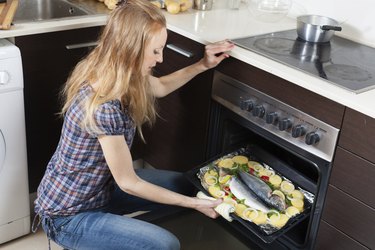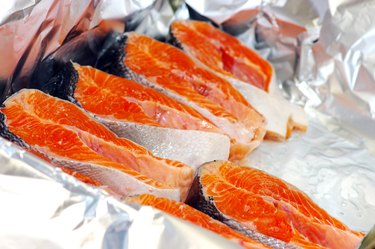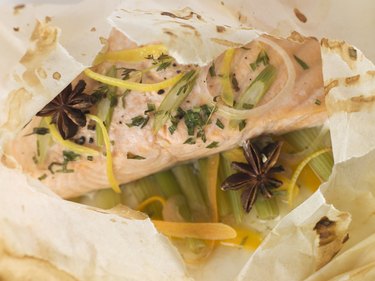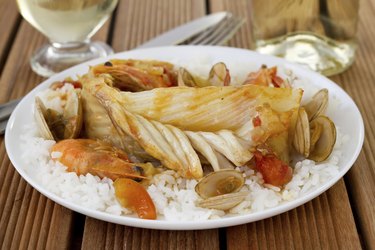
Cooking seafood on a regular basis is an appealingly low-stress way to eat healthier. Fish is a good source of high-quality protein, and even relatively fatty fish are low in saturated fats and high in heart-healthy omega-3 fatty acids. Of course, your choice of preparation methods matters as well. Fish that's battered and deep-fried isn't health food by any standard. Baking and broiling are much better options, adding little or no extra fat. Neither method is intrinsically superior, so choose whichever is best for a specific meal.
Baking vs. Broiling Techniques
Video of the Day

Both baking and broiling take place in your oven, so the differences between the two techniques might not be immediately obvious. When you bake fish, the heat is carried through your oven by slow-moving natural currents of hot air. It's a relatively inefficient way to transfer heat, which is why baking takes a relatively long time. Convection ovens, which use a fan to circulate the hot air, can shorten baking time considerably. When you broil fish, it's placed closer to the element at the top of your oven. It's not hot air that cooks the fish, but the infrared energy radiating from the element itself. It's a much faster cooking method, but with some sharp limitations.
Video of the Day
Fish for Broiling

Not every kind of fish is suitable for broiling. The best are fish with high levels of natural oils, such as salmon, mackerel and swordfish. Their natural fat provides a degree of protection against overcooking under the intense heat of the broiler, and the fish will brown beautifully.
If you're cooking cod, haddock, or other lean fish, they can be broiled successfully if you brush the surface with a protective glaze or a thin layer of a high-temperature cooking oil. Very lean, thin and delicate fillets, such as sole, go from uncooked to overcooked in a heartbeat, and are very difficult to broil successfully.
Fish for Baking

Broiling requires constant attention, because it's so easy to overcook your fish. Baking is a more relaxed affair, because of the lower temperatures used. Whole fish, large fillets, or especially lean and fragile fish can be baked at temperatures between 300 and 350 degrees Fahrenheit, to preserve their moisture and delicate texture. Fish that might otherwise be broiled can be baked at higher temperatures, ranging from 400 F to 450 F. The broiler incinerates fresh herbs and many other garnishes, but oven-baked fish can take full advantage of these light, low-fat flavoring options.
Baking in Sauce

Many recipes call for fish to be dry-baked, sitting on a sheet pan. Baking them in a sauce or flavored liquid is an alternative with much to recommend it. Simple cooking liquids, such as fish broth or spiced white wine, impart a gentle flavor to the fish with few or no added calories. More elaborate sauces based on tomatoes or tropical fruits are just as effective at keeping the fish moist, and also simplify your mealtime preparation process. The fish and sauce require only a simple side dish, such as fresh pasta or steamed rice, to make a memorable meal.